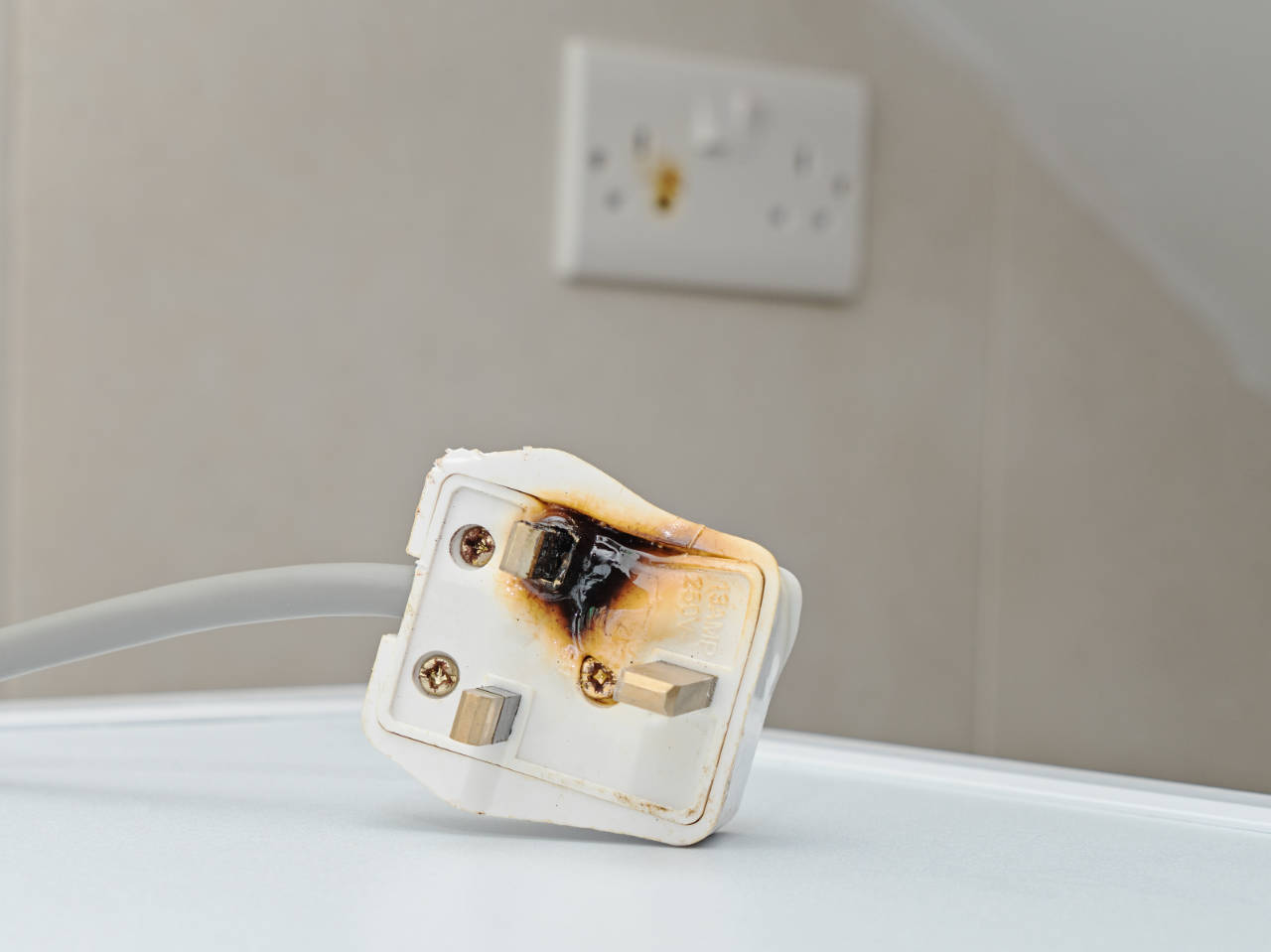
- Understand how the Electricity at Work Regulations (1989) affect your business.
- Identify common electrical hazards – from damaged equipment to overloaded sockets.
- Learn how to protect employees from electrical hazards.
You can listen to an audio version of this blog here:
While your workplace may not seem a high-risk environment for electrical injuries, all businesses should consider electrical safety. Electrical hazards can cause life-changing injuries or death, but they are unlikely to cause harm if properly managed.
This guide details the electrical hazards to be aware of and how to mitigate the risks.
What are an employer’s responsibilities?
For employers, maintaining a healthy and safe workplace is vital – and electrical safety is part of that. Employers risk fines for not complying with the Electricity at Work Regulations (1989) so it is essential to be aware of electrical hazards in the workplace.
Every year, around 1,000 accidents at work involving electricity are reported to the Health and Safety Executive and about 30 people die from injuries caused by electrical hazards.
Under the law, employers must make sure all electrical equipment is safe. It should be checked, properly installed and regularly inspected and maintained by a qualified, competent person.
Employers must carry out an electrical risk assessment of any electrical hazards. The assessment should detail who could be harmed by electrical hazards, how the level of risk has been established and the precautions that have been taken to control the risk. You must provide staff with training on electrical safety in the workplace.
Employers are also required to report certain incidents and injuries to RIDDOR.
What injuries can be caused by electrical hazards?
The main injuries caused by electrical hazards are:
- Electric shock: Electric shocks occur when someone comes into direct contact with an electrical current, leading to burns, muscle contractions, and even cardiac arrest.
- Burns: Electrical burns can occur when electrical current passes through the body, causing damage to the skin and underlying tissues.
- Arc flash: An arc flash is a sudden explosion of electrical energy. This can cause severe burns, shrapnel injuries, and even deafness.
- Thermal burns: Electrical equipment and wiring can get hot when overloaded or malfunctioning, leading to thermal burns if touched.
- Falls and other secondary injuries: Sometimes an electrical hazard can cause a worker to lose balance or fall from heights.
- Muscular injuries: Muscle contractions due to electric shocks can result in sprains, strains, or other muscular injuries.
- Cardiac-related issues: Severe electric shocks can disrupt the normal rhythms of the heart, leading to cardiac arrest or other heart-related issues.
- Respiratory issues: Inhaling smoke or fumes from electrical fires can cause respiratory problems, especially if toxic materials are involved.
Eight common electrical hazards
Many appliances and equipment in the workplace present an electrical hazard, but the most common hazards are:
1. Damaged equipment and power tools
Using damaged electrical equipment, such as construction power tools, can be very dangerous. Broken tools and equipment should not be used until they are fixed and certified by an individual who is qualified and competent to do so.
2. Frayed, loose or exposed electrical cables
Electrical cords on equipment contain securely insulated live wires. If the cable becomes frayed or cracked, the live wire can be exposed and lead to electrical fires or electric shock. Damaged cables should be reported and repaired by a qualified person, and should not be temporarily fixed with tape.
3. Using electrical equipment near water or with wet hands
Water can significantly increase the chance of electrocution so electrical equipment should not be used near a source of water or operated with wet hands. If the equipment does get wet, a qualified electrician should inspect it before it is used again.
4. Overhead power lines
The high voltage in overhead electrical lines can result in significant burns and electrocution. If you have workers working near overhead power lines, it is recommended that a minimum distance of 10 feet from the lines and nearby equipment is maintained. Do not store equipment or materials under overhead power lines and use safety barriers and signs to warn others of the hazard.
5. Incorrect use of replacement fuses
If you are fitting or replacing a fuse, you must use the right fuse for the appliance so that it doesn’t overheat. Check the manual or the label on the appliance to find out the wattage and the correct fuse required.
6. Overloaded sockets
Many offices are full of computers and other equipment that all need plugging in, often with lots of extension leads and adapters that can result in a spaghetti of cables and plugs. Ideally, an individual power socket should provide electricity to a single item, such as a computer monitor or printer.
If you do need to power several appliances from a single socket, use a fused, multi-way bar extension lead with surge protection rather than relying on a basic block adapter when plugging in additional equipment.
Do not overload the extension lead by plugging in several appliances that exceed the maximum electrical current level stated for the extension lead. Never plug an extension lead into another extension lead.
7. Smoke and smells from equipment
A smell of hot plastic, sparks or smoke coming from plugs, appliances or sockets are signs of an electrical hazard so keep an eye out for these danger signs. Get help from a qualified person and turn off the electrical supply to any equipment that appears to develop an electrical fault.
8. Improper grounding
All electrical equipment and devices must be earthed or grounded. If not, you are at risk of electrocution. Make sure that electrical equipment is periodically checked and certified by a qualified, competent person.
Who is most at risk from electrical hazards?
Engineers, electricians, engineers and overhead line workers are among the professions that are most exposed to electrical hazards. Installation, repairs, inspection and maintenance of electrical equipment are common activities that lead to accidents.
Agricultural workers are also at high risk because machinery or equipment can come into contact with overhead power lines on farmland.
On average, one farm worker dies this way each year, and in the five years to 2018, there were 1,140 near-miss incidents involving machinery and equipment contacting overhead electric power lines where serious injury or death was a possibility.
Most workplaces have some electrical hazards, though. The high volume of electrical equipment in most offices can expose workers to shocks, burns and fire.
Eight ways to prevent electrical accidents
By following these precautions and promoting a culture of electrical safety in the workplace, employers can significantly reduce the risk of electrical accidents and create a safer working environment for employees.
1. Raise employee awareness of electrical hazards
Employers should make sure all employees are aware of electrical safety at work and electrical safety procedures and guidelines.
Employees should be encouraged to notice risks and if they spot faulty equipment or another electrical hazard, to report it to a supervisor or whoever is in charge. The equipment should stop being used immediately and be checked by a qualified person.
To prevent electrical accidents in the workplace, employers should provide proper training to employees who work with electrical equipment to ensure they understand how to use it safely.
Help keep your workplace safe from electrical hazards with our Electrical Safety online training course. Tailored to employees, it helps staff identify electrical hazards at work and understand how to manage them. Our comprehensive course, IOSH Working Safely, also covers electrical hazards in the workplace.
2. Prevent overloading sockets
Ensure there are enough electrical sockets to meet the needs of the workplace to prevent overloading. Discourage the use of multiple adaptors or extension cords on a single socket.
3. Ensure proper use and maintenance
Emphasize the importance of switching off and unplugging electrical appliances before cleaning or performing maintenance on them. Ensure that all electrical appliances are turned off at the end of the workday.
4. Manage electrical cables
Regularly inspect and manage electrical cables to avoid tripping hazards.
Encourage employees to watch for trailing cables and secure them to prevent tripping or falling accidents. Make sure electrical cords do not run through high-traffic areas, across doorways, or under carpets, as they could become damaged or pose a tripping hazard.
5. Ensure employees working with electricity are qualified
Ensure that employees working with electricity are competent and qualified to perform their tasks safely:
‘No person shall be engaged in any work activity where technical knowledge or experience is necessary to prevent danger or, where appropriate, injury, unless he possesses such knowledge or experience, or is under such degree of supervision as may be appropriate having regard to the nature of the work.’ The Electricity at Work Regulations 1989
Regularly review and update their training to keep them informed about the latest safety practices.
6. Maintain dry conditions
Keep floors and work surfaces dry to prevent electrical equipment from coming into contact with water or other liquids.
Implement proper drainage systems and address any leaks promptly.
7. Maintain clearance around electrical panels
Maintain a minimum of three feet of clearance in front of electrical panels to allow for easy access in case of emergencies or maintenance.
8. Carry out regular inspections and maintenance
Schedule regular inspections and maintenance of electrical equipment to identify and address potential hazards before they become serious issues.

Electrical safety training with Praxis42
Our electrical safety training course will help your employees understand the risks in working with electrical equipment and systems and how to identify obvious defects in electrical equipment.
To find out more, please visit our Electrical Safety training webpage, or contact our friendly team today on 0203 011 4242 or info@praxis42.com.

Adam Clarke
Managing Director (Consulting)
